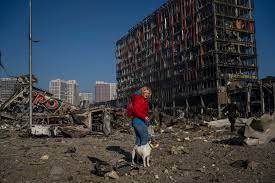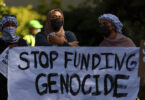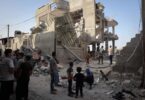Olha Zaiarna
In Kyiv, the silence of another summer evening is broken by the loud, piercing sound of an air raid warning. The alert app on our mobile phone sends out a warning to take cover, and Telegram channels inform us that the air defence system is operating, so we need to be careful.
Since the start of Russia’s full-scale invasion, the people of Ukraine have been living in a state of constant watchfulness, adjusting their lives to the lack of sleep and psychological consequences of terror from above.
The chaos within Russia over the past few days makes the question of what comes next for Ukraine even more important. Yes, there have been many stories of Ukrainians’ resilience and cooperation in the face of disaster. But this ugly war has caused us heavy losses, tearing at the fabric of society. A large number of people have experienced traumatic events and suffer from PTSD. Traditional patriarchal family structures have been unexpectedly and irrevocably changed, with women and men adopting new social roles. The displacement of communities has broken many pre-existing social ties, making many professional, social and family activities impossible. Reintegration questions over housing and services have exacerbated tensions and undermined social cohesion. There is a lot of talk now about the reconstruction and restoration of Ukraine, with international attention focusing on military support, physical infrastructure and private investment. But this should not only be about healing physical wounds but also psychological and emotional ones. Cohesive societies are more resilient to shocks, and rebuilding psychological bridges is equally vital to resisting and overcoming the Russian invasion in the long term.
This is where civil society organisations (CSOs) come into the picture. A vast network of mostly small organisations is holding Ukrainian society together. CSOs and informal networks of volunteers have provided the first line of response for both those who have remained in their communities and those who have been displaced. Conflict reduction organisations have provided the second line of assistance, and the broader mediation community has developed local, combined approaches to stitch together the altered and broken social ties that worked in peacetime. Over the past nine years, Ukrainian civil society has gained considerable experience in the integration of internally displaced persons into host communities, and in the psychological and physical rehabilitation of veterans. It has become expert in rapid volunteer cooperation. State authorities are able to organise logistics for humanitarian aid, for instance, but much of the knowledge about how to distribute it effectively and equitably lies with Ukrainian NGOs. They are ready and motivated to help.
Take the Mariupol-based women’s organisation, Berehynia, which has been helping people affected by the war since 2015. Years of work on developing its approach to dangerous situations has allowed it to save the lives of many people by evacuating them from the city under fire. It developed step-by-step action plan for dealing with dangerous situations, and was able to evacuate people as safely as possible after the full-scale invasion. It developed a mechanism for rapid coordination with local communities in other regions of Ukraine, local governments and communities abroad, including in Poland, where people were taken for temporary residence. It saved many lives when Mariupol came under fire.
The strength of such organisations is their local knowledge, connections and legitimacy with communities. They provide not only material support, but also social, psychological and public support, which are no less necessary. But the scale of the displacement calls for close cooperation with different levels of government and the international community. Ukraine’s decentralisation reforms since 2014 have transferred power to local communities. This has allowed groups such as International Alert, where I work, to interact more effectively with local authorities and NGOs and to get resources to communities that need them. In conversations with civil society representatives, I often hear that this has been a positive change, although one that is not yet complete. In order to increase the impact and align any support with the national recovery plan of Ukraine, we are calling on the international community to turn its attention to rebuilding the social infrastructure of Ukraine, as well as repairing the physical damage. This means ensuring CSOs are fully supported, resourced and strengthened.
Postwar recovery and reconstruction is a central demand of the Ukrainian population, a dream that follows the victory. But rebuilding Ukraine’s social infrastructure and supporting civil society is essential for a sustainable, long-term recovery.







